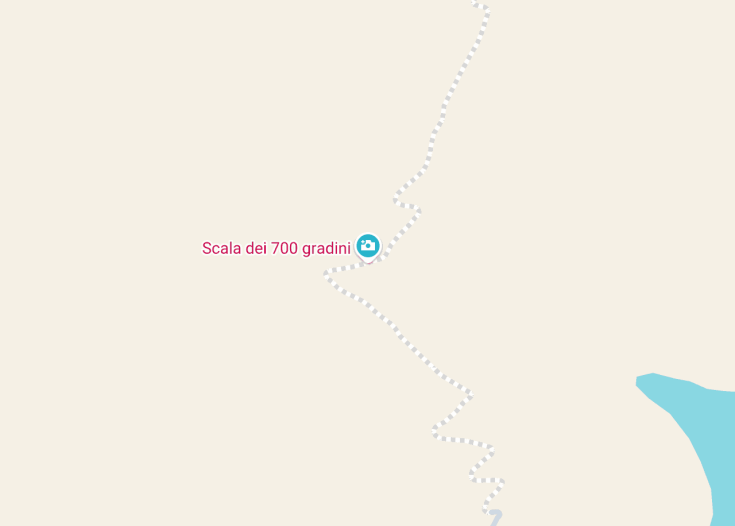Nestled in the rugged terrain of Italy, the Scala dei 700 Gradini (Stairway of 700 Steps) offers a unique blend of natural beauty and historic allure. This ancient staircase carves a path through the picturesque landscapes, providing a physical link to the past and a breathtaking panoramic view at its summit. Historically, it served as a critical access route for local villagers and has now become a symbolic journey for visitors, representing endurance and the reward of spectacular views. Whether you are a history enthusiast or a nature lover, Scala dei 700 Gradini presents an enriching experience that encapsulates the essence of Italian heritage.
Wear comfortable shoes and carry water; climbing the Scala dei 700 Gradini can be physically demanding but is ultimately rewarding with its stunning views.
To fully appreciate the historical significance, consider joining a guided tour that can provide insightful narratives about the staircase’s past and its surrounding area.
Scala dei 700 gradini: A Journey Through History and Nature
The Scala dei 700 Gradini, located in the picturesque village of Sant’Agata sui due Golfi in Italy, offers a unique blend of historical significance and breathtaking natural beauty. Originally constructed to connect the village to the Amalfi coast, the path comprises of 700 stone steps that meander through lush, verdant landscapes. This ancient staircase not only provides a scenic route for adventurous tourists but also holds a cultural resonance, reflecting the old ways of life where paths and staircases were the main connections between remote areas.
The climb, while challenging, rewards hikers with spectacular views of the Tyrrhenian Sea and the surrounding countryside. A popular spot for both photography enthusiasts and nature lovers, the Scala dei 700 Gradini also serves as a testament to human endurance and architectural ingenuity. It is a must-visit for those seeking to immerse themselves in Italy’s rich history and natural beauty.
Exploring the Historical Path
The Scala dei 700 Gradini is not just a physical challenge; it’s a journey through time. As you ascend the ancient steps, you will encounter various historical and natural landmarks. Midway, a small chapel offers a moment of respite and reflection. The path is also surrounded by traditional Mediterranean flora, inviting hikers to learn about the local ecosystem.
For those interested in photography, the changing perspectives provide numerous opportunities for capturing the stunning landscapes of Sant’Agata sui due Golfi. Whether it’s enjoying the serene environment or seeking a vigorous hike, the Scala offers a compelling blend of activities for all visitors.
Discover the Panoramic Vistas
One of the most rewarding aspects of climbing the Scala dei 700 Gradini is the panoramic view it offers at the summit. Upon reaching the top, hikers are greeted with a breathtaking vista of the Tyrrhenian Sea, framed by rugged cliffs and lush greenery.
This spot is perfect for a rest while soaking in the spectacular sights, making the strenuous climb worthwhile. The view encapsulates the beauty of Italy’s coastline and is an ideal location for unforgettable photos that capture the essence of the Amalfi coast. Visitors often spend time here, enjoying the peaceful ambiance and the spectacular horizon stretched out before them.
Discover the Scala dei 700 gradini
Suitable for adventurous souls and lovers of history, the Scala dei 700 gradini offers a unique journey into the past and a challenging trek perfect for fitness enthusiasts. This destination is a gem for those who enjoy exploring rugged terrains and are captivated by scenic views. Parents with children, older individuals, or anyone with mobility issues may find the climb strenuous, but the breathtaking views from the top are a splendid reward for those who undertake the climb.
Best time to visit Scala dei 700 gradini
Visiting during the spring or early autumn is ideal as the weather is mild and the landscape is in bloom or just starting to show autumn colors. These seasons provide an optimal experience for climbing and enjoying the panoramic views without the harsh summer heat or winter cold.
Annual Events
If you are looking for a unique time to visit, consider planning your trip during the local festival in early May, when the historical significance of the Scala is celebrated with guided tours and cultural performances, enhancing the visiting experience.
About accessibility and limitations
The steep and rugged nature of Scala dei 700 gradini can pose a challenge to those who are not adequately prepared for a physically demanding hike.
Accessibility
Due to its historical structure, the Scala dei 700 gradini is not wheelchair accessible and can be difficult for those with mobility limitations.
Limitations
Before planning your visit, consider the following limitations:
- Rugged terrain not suitable for wheelchairs or strollers
- No rest areas along the climb
- Limited shade, making sunny days particularly challenging
Notes to visitors
Keep these points in mind:
- Carry water and wear appropriate shoes
- Weather can affect the climb’s difficulty
- Early morning or late afternoon visits are advisable to avoid the midday sun
General informations
Here’s everything you need to know for your visit to Scala dei 700 gradini.
Location
The Scala dei 700 gradini is nestled near several notable landmarks and can be accessed via a short trek from the town center. Several footpaths and signposted routes lead visitors directly to the base of the Scala.
Address:
Via Scala, 20, Sant’Agata sui due Golfi, Italy
Opening hours
The Scala dei 700 gradini is open year-round, 24 hours a day, but it’s best accessed during daylight hours for safety and visibility.
How to reach the Scala dei 700 gradini
Car
Visitors can drive to Sant’Agata sui due Golfi, where parking is available near the town center. From there, the Scala is a short walk away.
| Route | Distance | Travel time |
|---|---|---|
| From Naples | 60 km | 1 hour 15 minutes |
| From Sorrento | 15 km | 25 minutes |
| From Positano | 30 km | 1 hour |
Bus
Regular bus services connect Sant’Agata sui due Golfi with major nearby cities. Check the local bus schedules for the most recent timings.
| From | Travel Time |
|---|---|
| Naples | 1.5 hours |
| Sorrento | 30 minutes |
| Positano | 45 minutes |
Nearby Attractions
Explore these attractions near Scala dei 700 gradini:
- Villa Romana – 2 km (1.2 miles)
- Church of Santa Maria delle Grazie – 3 km (1.8 miles)
- Antiquarium of Boscoreale – 12 km (7.5 miles)
- Pompeii Archaeological Park – 30 km (18.6 miles)
- Capri – 35 km (21.7 miles)
- Ravello – 39 km (24.2 miles)
- Mount Vesuvius – 40 km (25 miles)
- Amalfi Coast – 50 km (31 miles)
- Hermitage of San Michele – 14 km (8.7 miles)
- Coral Museum – 44 km (27 miles)
- Castello di Lettere – 48 km (29.8 miles)
- Royal Palace of Naples – 60 km (37.2 miles)
Common questions
What is the historical significance of Scala dei 700 gradini?
What type of safety measures are in place at Scala dei 700 gradini?
Are there guided tours available for Scala dei 700 gradini?
What is the best time of year to visit Scala dei 700 gradini?
What should visitors wear while exploring Scala dei 700 gradini?
Is the Scala dei 700 gradini suitable for children?
What flora and fauna can be observed around Scala dei 700 gradini?
Are there any nearby attractions to explore along with Scala dei 700 gradini?

Is the Scala dei 700 gradini in Sant’Agata sui due Golfi worth the visit?
The Scala dei 700 Gradini, located in Sant’Agata sui due Golfi, presents an intriguing opportunity for tourists seeking an authentic slice of Italian history fused with a physical challenge. This monumental staircase digs deep into the area’s historical roots, providing visitors with a literal step-by-step recount of ancient practices and architectural styles. However, the staircase, as the name suggests, comprises 700 steps, which can be a formidable challenge for many.
The physically demanding nature of the climb combined with the lack of regular resting spots or amenities makes it less suitable for everyone. Those with mobility issues or low stamina might find the experience more grueling than enjoyable. Therefore, while it’s worth a visit for fit and adventurous travelers hungry for historical exploration and picturesque views, others might consider less strenuous yet equally enriching alternatives in the region.










